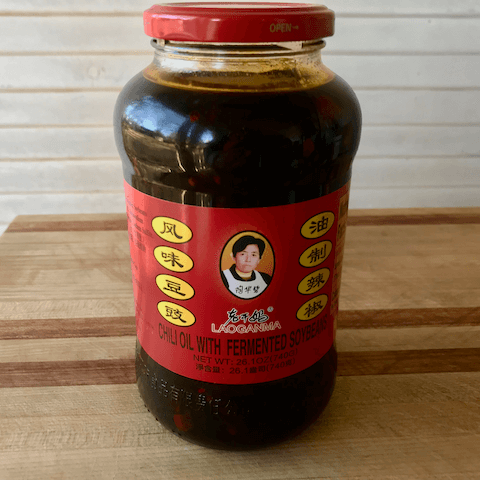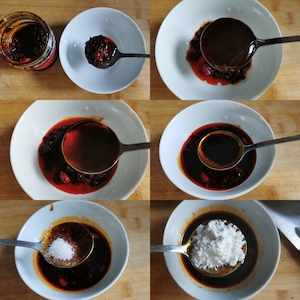Laoganma offers many flavors of chili oil and chili crisp. The Laoganma brand is very popular worldwide. We typically use Laoganma Chili Oil with Black Bean Paste in our recipes on My Chinese Home Kitchen, and it adds a delicious umami (savory) flavor to recipes. A teaspoon or two goes a long way! This sauce is essential to the taste of our General Tso’s Chicken, Spicy Clams with Black Beans, Cumin Squid Tentacles, and Chinese Fried Noodles recipes.

The other bean paste that we use is quite different in flavor, and is a staple in Sichuan cooking. Called Doubanjiang, it is a paste made from oil, wheat, and broad beans (or fava beans) with red chili peppers.
The Laoganma (“Old Godmother”) brand
Laoganma was started by a widow named Tao Huabi from the mountainous province of Guizhou. She was born in 1947, the eight child of a poor family, and never attended school. After her husband died she started a restaurant selling noodles with her own chili sauce. The sauce became popular and she now runs a company that produces nearly as much volume as Heinz. Helen Sullivan, in the Guardian, recently wrote a short biography of Tao Huabi and her rags to riches story.
Laoganma claims to be the most popular chili sauce in China, and is very popular around the world. The name literally translates as “Old Godmother.” Laoganma Chili Oil with Black Bean Paste has a mild, and slightly sweet flavor, and is a delicious addition to recipes. The sauce is a blend of soybean oil, fermented soybeans, chili peppers, onion, salt, sugar, peanuts, and monosodium glutamate.
Cooking with Laoganma Chili Oil with Black Bean
Unlike Western cooking, where condiments are used to flavor food after cooking, in Chinese cuisine, sauces such as those offered by Laoganma are used to infuse the oil or protein in a dish with flavor while stir-frying.
For example, with our Chinese Clams with Black Bean Sauce, Cold Noodles, and General Tso’s Chicken, Laoganma Chili Oil with Black Bean Paste is added to the sauce during preparation. When cooking, the aromatic ingredients are stir-fried in the oil to build aroma and flavor, then the sauce is added, then the protein is added to soak up the flavor of the sauce in the wok.

With our scallop, squid tentacles, and fried noodles recipes, Jing adds the aromatics, then the protein, then the Laoganma Chili Oil with Black Bean Paste to flavor the protein while stir-frying.

Where to buy Laoganma sauces
You can find several re-sellers for Laoganma Chili Oil with Black Bean on Amazon.
Yamibuy also carries Laoganma Chili Crisp and the Chili Oil with Black Bean.
A note about MSG
MSG is considered safe, though some people prefer to avoid it. Most adults consume glutamate everyday without realizing it. The natural form, glutamic acid, is found in some vegetables such as tomatoes, and cheese. Information about MSG can be found at the Mayo Clinic’s website, and the FDA. According to the FDA listing for monosodium glutamate:
MSG is produced by the fermentation of starch, sugar beets, sugar cane or molasses. This fermentation process is similar to that used to make yogurt, vinegar and wine…. FDA considers the addition of MSG to foods to be “generally recognized as safe” (GRAS). Although many people identify themselves as sensitive to MSG, in studies with such individuals given MSG or a placebo, scientists have not been able to consistently trigger reactions….The glutamate in MSG is chemically indistinguishable from glutamate present in food proteins. Our bodies ultimately metabolize both sources of glutamate in the same way. An average adult consumes approximately 13 grams of glutamate each day from the protein in food, while intake of added MSG is estimates at around 0.55 grams per day.
https://www.fda.gov/food/food-additives-petitions/questions-and-answers-monosodium-glutamate-msg
The controversy over MSG comes down to two arguments. One is that good cooks do not need a flavor enhancer in their foods. The other has more to do with anti-Asian bias in Western societies: many foods have naturally occurring glutamate, and many canned foods have MSG added, but Westerners only associate MSG with Chinese restaurant food. If you are interest to learn more, please see our article about monosodium glutamate. As for our few recipes that list MSG, it is considered optional.
Do you enjoy My Chinese Home Kitchen?
We enjoy sharing these authentic home recipes with you. Learn more about My Chinese Home Kitchen at our About page.
Please leave a comment, or SUBSCRIBE to our newsletter.
For more of our original videos, visit My Chinese Home Kitchen on YouTube and Rumble.


